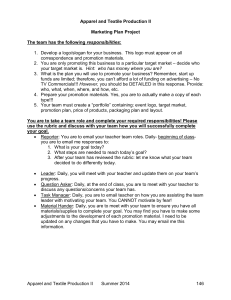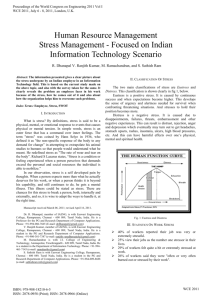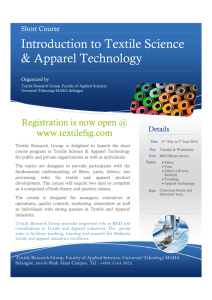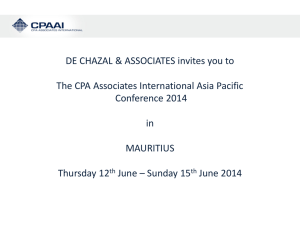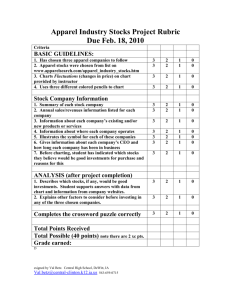Key Success Factors for the Apparel Manufacturing Industry: A Case
advertisement
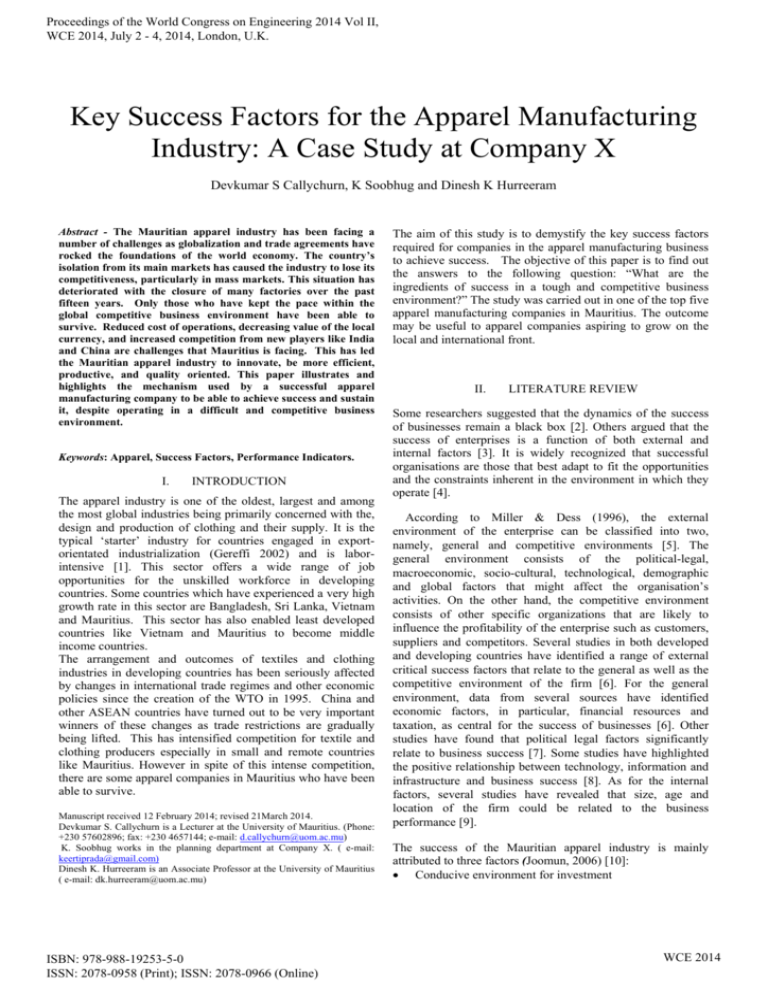
Proceedings of the World Congress on Engineering 2014 Vol II, WCE 2014, July 2 - 4, 2014, London, U.K. Key Success Factors for the Apparel Manufacturing Industry: A Case Study at Company X Devkumar S Callychurn, K Soobhug and Dinesh K Hurreeram Abstract - The Mauritian apparel industry has been facing a number of challenges as globalization and trade agreements have rocked the foundations of the world economy. The country’s isolation from its main markets has caused the industry to lose its competitiveness, particularly in mass markets. This situation has deteriorated with the closure of many factories over the past fifteen years. Only those who have kept the pace within the global competitive business environment have been able to survive. Reduced cost of operations, decreasing value of the local currency, and increased competition from new players like India and China are challenges that Mauritius is facing. This has led the Mauritian apparel industry to innovate, be more efficient, productive, and quality oriented. This paper illustrates and highlights the mechanism used by a successful apparel manufacturing company to be able to achieve success and sustain it, despite operating in a difficult and competitive business environment. Keywords: Apparel, Success Factors, Performance Indicators. I. INTRODUCTION The apparel industry is one of the oldest, largest and among the most global industries being primarily concerned with the, design and production of clothing and their supply. It is the typical ‘starter’ industry for countries engaged in exportorientated industrialization (Gereffi 2002) and is laborintensive [1]. This sector offers a wide range of job opportunities for the unskilled workforce in developing countries. Some countries which have experienced a very high growth rate in this sector are Bangladesh, Sri Lanka, Vietnam and Mauritius. This sector has also enabled least developed countries like Vietnam and Mauritius to become middle income countries. The arrangement and outcomes of textiles and clothing industries in developing countries has been seriously affected by changes in international trade regimes and other economic policies since the creation of the WTO in 1995. China and other ASEAN countries have turned out to be very important winners of these changes as trade restrictions are gradually being lifted. This has intensified competition for textile and clothing producers especially in small and remote countries like Mauritius. However in spite of this intense competition, there are some apparel companies in Mauritius who have been able to survive. Manuscript received 12 February 2014; revised 21March 2014. Devkumar S. Callychurn is a Lecturer at the University of Mauritius. (Phone: +230 57602896; fax: +230 4657144; e-mail: d.callychurn@uom.ac.mu) K. Soobhug works in the planning department at Company X. ( e-mail: keertiprada@gmail.com) Dinesh K. Hurreeram is an Associate Professor at the University of Mauritius ( e-mail: dk.hurreeram@uom.ac.mu) ISBN: 978-988-19253-5-0 ISSN: 2078-0958 (Print); ISSN: 2078-0966 (Online) The aim of this study is to demystify the key success factors required for companies in the apparel manufacturing business to achieve success. The objective of this paper is to find out the answers to the following question: “What are the ingredients of success in a tough and competitive business environment?” The study was carried out in one of the top five apparel manufacturing companies in Mauritius. The outcome may be useful to apparel companies aspiring to grow on the local and international front. II. LITERATURE REVIEW Some researchers suggested that the dynamics of the success of businesses remain a black box [2]. Others argued that the success of enterprises is a function of both external and internal factors [3]. It is widely recognized that successful organisations are those that best adapt to fit the opportunities and the constraints inherent in the environment in which they operate [4]. According to Miller & Dess (1996), the external environment of the enterprise can be classified into two, namely, general and competitive environments [5]. The general environment consists of the political-legal, macroeconomic, socio-cultural, technological, demographic and global factors that might affect the organisation’s activities. On the other hand, the competitive environment consists of other specific organizations that are likely to influence the profitability of the enterprise such as customers, suppliers and competitors. Several studies in both developed and developing countries have identified a range of external critical success factors that relate to the general as well as the competitive environment of the firm [6]. For the general environment, data from several sources have identified economic factors, in particular, financial resources and taxation, as central for the success of businesses [6]. Other studies have found that political legal factors significantly relate to business success [7]. Some studies have highlighted the positive relationship between technology, information and infrastructure and business success [8]. As for the internal factors, several studies have revealed that size, age and location of the firm could be related to the business performance [9]. The success of the Mauritian apparel industry is mainly attributed to three factors (Joomun, 2006) [10]: Conducive environment for investment WCE 2014 Proceedings of the World Congress on Engineering 2014 Vol II, WCE 2014, July 2 - 4, 2014, London, U.K. The launching of the Export Processing Zone (EPZ) in 1971 access to the EU market. Steps for sustainable growth and structural adjustments were taken in 1980, 1986, 1995 and 2000 were taken by the successive governments to enable access to new markets and to further build capacity for growth. Exogenous factors The Multi-Fibre Agreement signed in 1982 contributed positively to the Mauritian textile and clothing sector economy by constraining several other countries in their exports. This led foreign investors, e.g. from Hong Kong, to set up their businesses in Mauritius, bringing capital, marketing, networks and technological know-how. Preferential Trade Arrangements Favorable terms of trade combined with ready markets attracted more foreign investors to set up their textile and garments firms in Mauritius. Investors, both domestic and foreign, successfully exploited all the preferential market access granted by the developed countries. The two main markets, which Mauritius could access through preferential trade agreements, were the EU and the US under the Lomé Convention and the GSP (now AGOA) respectively. Moreover there have been more factors contributing to the success of the textile and clothing subsectors such as, commitment, reliability, faithfulness to buyers, customer satisfaction, quality of products and services, timely delivery, competitive pricing, positive business environment and corporate social responsibility [10]. The failure of the industry was due to the fact that all stakeholders failed to rapidly adapt to the changing economic environment and also on their will to meet new challenges. III. CASE STUDY AT COMPANY X Company Profile Company X is part of an international group founded in 1978, which has grown to become a leading cotton shirt maker. The annual revenue of the company averages US$1.2 billion and produces 100 million shirts each year for leading brands and retailers across the globe. It has a workforce of 54,000. Apart from Mauritius Company X have production facilities in China, Malaysia, Vietnam, and Sri Lanka, and a network of merchandising offices servicing key markets in mainland China, Japan, Europe and the US. With its strategically positioned merchandising offices and state-of-the-art facilities throughout the world, Company X is well placed to serve its business partners around the globe by working together on tomorrow’s solutions streamlined though a centralized and integrated global network. Company X is vertically integrated to gain optimal control of the supply chain, ensuring high quality at every stage of production; from cotton farming to ISBN: 978-988-19253-5-0 ISSN: 2078-0958 (Print); ISSN: 2078-0966 (Online) encouraged and supported exports through preferential point-of-sale. Supplementing Company X’s vertically integrated supply chain are devoted teams to provide “Total Shirt Solutions” from customer relationship management to order management and fulfillment in areas of merchandising, design, trims, and packaging, product development and more, which gives Company X the cutting edge in the textile and apparel industry. IV. METHODOLOGY The primary aim of the paper was to use the case study method to identify the key factors leading to success of Company X. Data was collected through personal interviews with company executives and line managers involved with each functional area The Financial statements of the company have been used to gain further insight about the performance of the company over a three year period. The performance and productivity monitoring and management (PM) 2 model developed by Hurreeram et al. (2012) was used to assess the non financial indicators [11]. V. FINDINGS Performance measures The success of Company X is largely attributed to a close monitoring of key indicators for each functional area at different intervals in the short term to medium term. The data compiled over the period 2011 to 2013 is illustrated in Table I. This particular department buys raw materials and accessories for making of the garments. The department also looks after stock and communicates the information to the factory. It furthermore ensures that the Quality Controllers (QC) carry out inspections on the garments prior to shipment. Broadly speaking, the management of materials concerns the entire range of functions which affect the flow, conservation, utilization, quality and cost on materials. Six performance indicators are measured which show a positive result for instance, the percentage of late receipt is very low and the defective items percentage is within tolerance. A significant decrease in the late receipts has been observed, from 2% in 2011 to 1% in 2013, as shown in figure 1. This demonstrates the capacity of Company X to build a trustworthy and good relationship with its suppliers. The latter has shown its reliability with regards to the quality and quantity of raw materials delivered as can be shown in the figure 1 below. From the data it can also be observed that it is very rare that goods once ordered are returned to the suppliers WCE 2014 Proceedings of the World Congress on Engineering 2014 Vol II, WCE 2014, July 2 - 4, 2014, London, U.K. Table I: Performance Measures for Company X (Mauritius)Ltd from 2011 to 2013 Purchasing and Store . ISBN: 978-988-19253-5-0 ISSN: 2078-0958 (Print); ISSN: 2078-0966 (Online) WCE 2014 Proceedings of the World Congress on Engineering 2014 Vol II, WCE 2014, July 2 - 4, 2014, London, U.K. Performance (Percentage) Management of purchasing 2.50% 2.00% 1.50% 1.00% 0.50% 0.00% % of late receipts (W) 2011 % deviation % of defective from quantity items received (M) ordered (M)(tolerance is +/-5% Indicators 2012 Management of raw materials 100.0% 90.0% 80.0% 70.0% 60.0% 50.0% 40.0% 30.0% 20.0% 10.0% 0.0% Quantity and value of Material productivity (W) leftover after order delivery (Q) 2013 2011 2012 2013 Fig 1: Performance indicators for the purchasing and store department Due to the relatively good performance of the purchasing department and of the materials management department, Company X has reaped the following benefits, which also directly or indirectly impacted on other departments: Maintaining a continuity with regards to the supply of materials to support the production schedule and the organisation’s operations. Minimising duplication, waste, returns and obsolescence. Maintaining standards in the quality of materials. Developing good and reliable suppliers and ensuring satisfactory vendor relationships. Last but not the least, helping in maintaining the company’s competitive position in the industry by controlling costs related to materials. Production Production consists of the transformation of the raw materials (fabric) into finished products (Shirts) through a sequence of operations. The production lines have been observed to operate with an efficiency of 99.98% which is commendable. Moreover the rework and reject rates are within tolerance and delivery is always on time. Company X always fixes a completion date which is always before the delivery date set by the client. Thus Company X always does on-time delivery. The labour productivity is also relatively high thus contributing to the success of the company As shown in table 1 and figure 1, there has been an improvement in almost all the factors considered for production between the year 2011 and 2013. There has been a considerable decrease in the number of reworks which is the result of good materials management by the purchasing department as well as a rigid quality assurance procedure on the production line. Quality performance 90.00% 80.00% 70.00% 60.00% 50.00% 40.00% 30.00% 20.00% 10.00% 0.00% 10.00% Percentage quality Percentage Productivity 8.00% 6.00% 4.00% 2.00% 0.00% Line efficiency (D) 2011 2012 % line downtime 2013 % Rework (D) % Reject (D) Indicators 2011 2012 2013 Fig 2: Performance indicators for production department ISBN: 978-988-19253-5-0 ISSN: 2078-0958 (Print); ISSN: 2078-0966 (Online) WCE 2014 Proceedings of the World Congress on Engineering 2014 Vol II, WCE 2014, July 2 - 4, 2014, London, U.K. 4.00% 0.5 3.00% 0.4 0.3 2.00% 0.2 1.00% 0.1 0 0.00% 2011 2012 Year 2013 Profitability (A) Capital productivity (pcs/Rs) Financial performance Profitability as a percentage of turnover (%) Company X has moved from maintenance by default to maintenance by plan which indicates that there has been forethought to what level of maintenance is targeted. The good results obtained by the maintenance department for the years 2011 to 2013 can be explained by the fact that Company X makes use of the Preventive Maintenance (PM) programme. This has helped to extend the equipment life and ensure capacity, thus explaining the high utilization (90-95%) of plant and equipment over the past three years. With the implementation of the PM programme , Company X has been able to reduce the cost of maintenance, increase on-line time of operations equipment and helped in keeping the improvement in the line productivity over the years. Capital productivity (A) (pcs/Rs) Performance (Percentage) Maintenance management Fig 4: Performance indicators for the finance department 1.50% 1.00% 0.50% 0.00% % machine downtime Cost of maintenance/turnover Indicators 2011 2012 2013 Capital Productivity Capital productivity is regarded as the output per unit of value of fixed production assets (fixed capital). The increased capital productivity in 2012 compared to the 2011 figure confirms that the company has experienced an increased output. With a negligible rise from 0.339pcs/Rs to 0.34pcs/Rs between 2012 and 2013 in the ratio of generated/targeted profit, it becomes clear that the company has been able to maintain its production levels. Higher observed profits between 2012 and 2013 is therefore due to better cost control resulting in a higher profit margin per unit produced. Fig 3: Performance indicators for the maintenance department Finance Ratio of generated/targeted profit A rather stable ratio of generated/targeted profit is observed between 2011 and 2013. This indicates that the company is able to rather accurately forecast its sales, despite not being able to reach its targeted profit. Company X has however achieved over 90% of the targeted profit over the past 3 years. Perhaps a new study of the market, its forces, and driving factors may help in identifying ways of increasing revenue. Profitability The figures in table 1 provided represent the return on capital employed. Growing profitability figures since 2011 indicate that the company’s performance has been improving (from 2.85% in 2011 to 3.5% in 2013). This shows constant improvement by the company. It is also worthwhile noting that ROCE may also increase without an actual increase in profit owing to fully depreciated assets. The increased ROCE figures are comparable with ROCE figures of competing firms which explains the actual performance and position of the company within the industry. ISBN: 978-988-19253-5-0 ISSN: 2078-0958 (Print); ISSN: 2078-0966 (Online) Investment/Turnover ratio This indicator increased by 1 basis point in 2013 compared to 2012. Given a negligible change in capital productivity indicating a rather stable turnover, a higher investment/turnover ratio in 2013 is due to the investment made by the company in acquiring 2 new factories on the island so as to increase its production capacity. Performance related compensation/turnover The 18 basis points increase in this indicator indicates that the company has been remunerating its personnel better compared to previous years with the expectation that turnover has been rather stable. Since compensation is related to performance, this therefore suggests an increased profitability of the company in 2013 compared to 2012 in line with the observation made while analysing ROCE. Human Resource Department Human resource is the most valuable asset of any company. Company X offers opportunities for personal development and career growth under its e-culture. These form the core values that improve its competitiveness by inspiring its people, navigating the business strategies in carrying out the operations. Company X offers a safe, comfortable and healthy work environment to its employees. Another strength of the company is in its design and implementation of policies and WCE 2014 Proceedings of the World Congress on Engineering 2014 Vol II, WCE 2014, July 2 - 4, 2014, London, U.K. procedures to protect the health, safety and security of everyone in the workplace. Consequently the absenteeism rate is very low as shown in Table 1. Another important factor that has ensured the success of Company X over the years is its capacity to retain its labour. [4] Kallerberg,A.L., & Leicht,K.T.,1991. Gender and organisaitonal performance: Determinants of small business survival and success. Academy of Management Journal, 34(1), 136-161 [5] Miller, A., & Dess,G.,1996. Strategic Management (2nd ed.). New York: McGraw-Hill [6] Benzing, C., Chu, H.M., & Kara, O.,2009. Entrepreneurs in Turkey: A factor analysis of motivations, success factors and problems. Journal of small business management, 47(1), 58-91. [7] Beck, T., Demirguc-Kunt, A., & Maksimovic,V., 2006. The influence of financial and legal institutions and firm size. Journal of Banking and Finance, 30, 2995-3015. [8] Jasra,J.M.,2011. Determinants if business success of small and medium enterprises. International Journal of Business and Social Science, 2(20), pp. 274-280. [9] Bates, T., & Nucci,A.,1989. An analysis of small business size and rate of discontinuance, International Journal of Small Business Management, 27, pp.1-7. [10] Joomun, G., 2006. The Textile and Clothing Industry in Mauritius. The Future of the Textile and Clothing Industry in Sub-Saharan Africa, pp.193-195. [11] Hurreeram D.K., Callychurn DS, Ruggo A and Soobhug K, 2012, Performance Monitoring: Beyond Financial Indicators, Conference Proceeding, ICMR 2012. VI. CONCLUSIONS Unarguably, in spite of a fierce competitive international environment, Company X has been able to position itself as one of the key players in the Mauritian apparel industry. . In addition to the quantitative indicators, other success factors of company X include: Technology An increasing use of technology for the delivery of innovative solutions has been observed at Company X Internet, tactile tablets and software tools are for example are used by experts in quality which enable them to transmit a live control report, with data and photos. Company X further disposes a strong IT department to quickly address and resolve issues. Unlike other small or medium firms, Company X has invested heavily in technology to automate its business processes and to improve information gathering, access and quality. Branded Products Company X manufactures and exports high-quality products to leading international players. Some of the prestigious companies sourcing apparel from Company X include: Abercrombie & Fitch, Kohl's, Nautica, J. Crew, JC Penney, Jos. A. Bank, Tommy Hilfiger, Timberland, and Eddie Bauer. Labour Force Company X has a versatile labour force that can easily adapt to new manufacturing techniques. Most of the employees have over 15 years of experience in the industry. This paper sought to identify the factors that influence the success of Company X in the Mauritian apparel industry. The results of the quantitative study offered an understanding of the insights of the success factors of the organization. REFERENCES [1] Gereffi G., & Memedovic O., 2003. The Global Apparel Value Chain: What Prospects for Upgrading by Developing Countries. United Nations Industrial Development Organization, Vienna. [2] Ligthelm,A., A.,2010. Entrepreneurship and small business sustainability. Southern African Business Review, 14(3), 131-153. [3] Markman, G., & Baron, R., 2003. Person-entrepreneurship fit: Why some people are more successful as entrepreneurs than others. Human Resource Management Review, 13(2), 281-301. ISBN: 978-988-19253-5-0 ISSN: 2078-0958 (Print); ISSN: 2078-0966 (Online) WCE 2014
